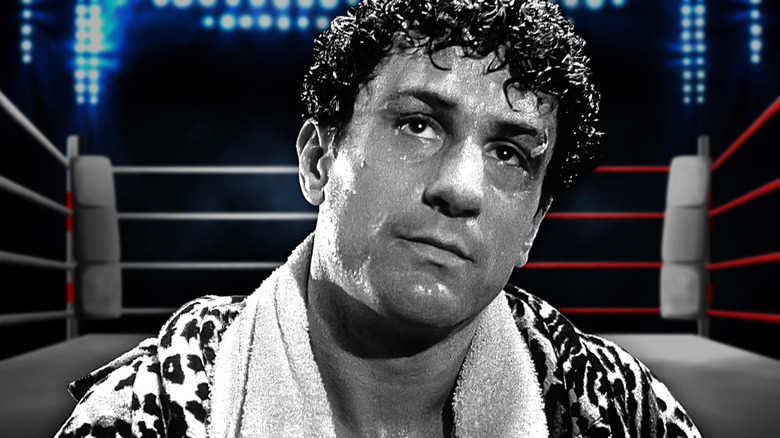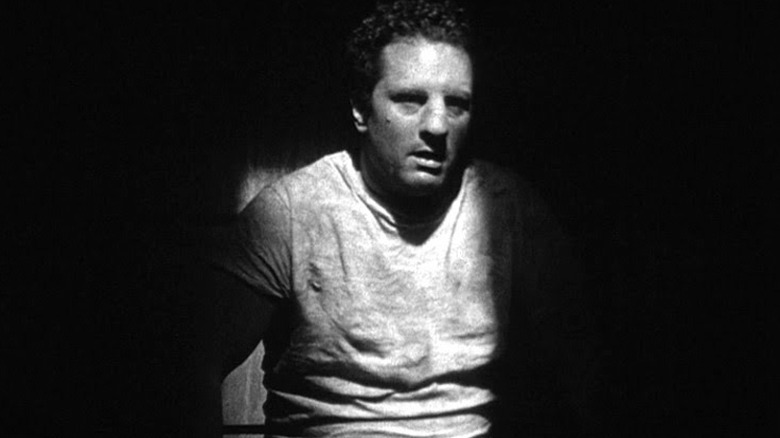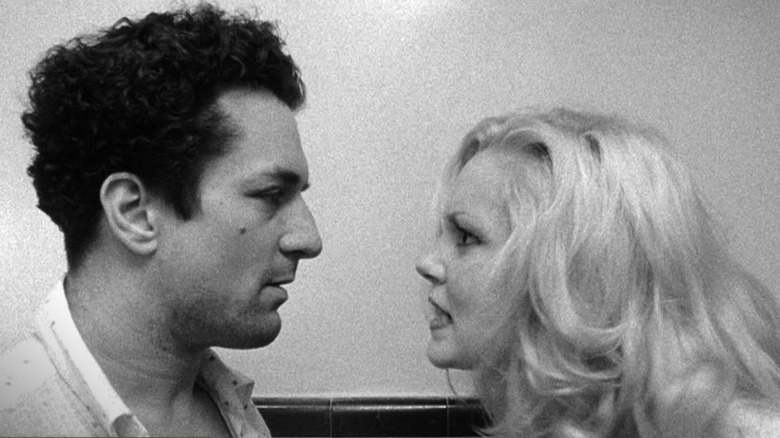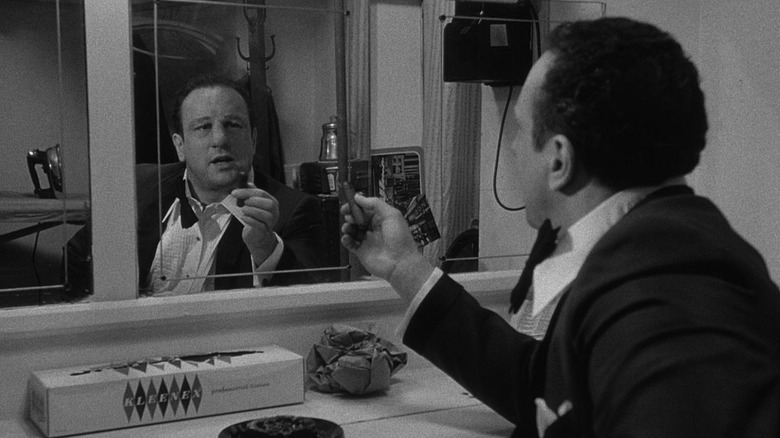In the course of the 2021 Tribeca Movie Pageant, Robert De Niro and Martin Scorsese mentioned their fourth movie collectively, “Raging Bull,” with moderator Leonardo DiCaprio. It is a brutal piece of cinema that makes use of black-and-white cinematography to replicate middleweight boxer Jake LaMotta’s grim outlook on the world as he finds success and shortly loses it. Violence and anger course by way of his veins, and LaMotta barrels by way of life outdoors the ring like a bull in a china store — destroying the whole lot and everybody in his path. Though it grew to become considered one in all Scorsese and De Niro’s most interesting works, “Raging Bull” had a rocky journey to the display screen.
De Niro first grew to become fascinated with Jake LaMotta’s story after studying his memoir, “Raging Bull: My Story,” and approached Martin Scorsese with the concept of adapting all of it the best way again in 1974, however they had been each not sure of how it might be obtained. How may a uncooked and ugly portrayal of an abusive boxer resonate with moviegoers? “We did not know the way properly it was going to do, however we knew it might be particular. It doesn’t matter what, it might be particular. It simply couldn’t not be due to the whole lot we put into it,” De Niro instructed Tribeca audiences. The actor-director duo endured heavy blows to carry the mission to life, from establishing the script to the filming course of and eventual launch.
A private disaster satisfied Scorsese to make Raging Bull
Martin Scorsese initially had hesitations about directing “Raging Bull” as a result of he discovered boxing, and sports activities generally, to be tedious:
“I wasn’t affected by the e book in any respect. Additionally, nothing towards sports activities, however having had extreme bronchial asthma and [being] instructed I could not run, I could not do that, I could not chortle . . . I used to be very sheltered and it stored me from any crew sports activities, which is unhappy in a technique, however then again it made me give attention to creativeness. I went to plenty of motion pictures” (by way of EW).
However in 1979, Scorsese had a revelation about Jake LaMotta’s life story that got here from his personal drug-related overdose. As reported in The New Yorker, Robert De Niro visited Scorsese within the hospital after his near-death expertise and pitched “Raging Bull” once more as a probably life-saving mission. De Niro knew that if Scorsese may pour all his creative ambition into the shared aim of constructing this redemptive story, he would have a purpose to greet every new day.
Scorsese gained a deeper emotional understanding of LaMotta’s self-destruction as a result of it mirrored his personal struggles with dependancy and restoration; he may now view “Raging Bull” as one thing greater than only a typical boxing film. “I used to be misplaced in a manner, so I needed to begin yet again. It was a rebirth in a manner,” he instructed Tribeca audiences. Like LaMotta, Scorsese couldn’t management his overwhelming impulses and hit all-time low. Channeling his depleted power into artistic expression was the one manner he may climb again up. It’s Scorsese’s intimate consciousness of humanity’s darkest conduct that makes “Raging Bull” such a gritty and visceral masterpiece.
The battle for the very best screenplay
It took years and a devastating occasion for Robert De Niro to lastly persuade Martin Scorsese to adapt “Raging Bull,” however crafting the screenplay was one other powerful struggle. Mardik Martin, who had additionally written “Imply Streets,” wrote a draft that they disliked, in order that they introduced in “Taxi Driver” scribe Paul Schrader. “I hated to do it after on a regular basis Mardik spent, however there was far more boxing than we wished,” Scorsese instructed The Observer.
Schrader’s model was much more tough, that includes a scene the place Jake LaMotta makes an attempt to masturbate in his jail cell that risked an X ranking. The ultimate model of that scene, the place Jake LaMotta weeps “I am not an animal” then vents his frustrations by pounding the concrete wall over and over and over, grew to become some of the gut-wrenching moments in “Raging Bull,” and highly effective sufficient with out the added sexuality. Scorsese and De Niro ended up spending a couple of weeks on the island of Sint Maarten to restructure the screenplay.
The memoir covers plenty of floor that the ultimate movie finally ends up ignoring, resembling Jake’s teenage years of theft, reform college, and the sexual assault of his finest pal’s girlfriend. As an alternative, “Raging Bull” concentrates on what fascinated Robert De Niro essentially the most about Jake LaMotta’s life: his physique transformation. “I stated, ‘Jesus, look what occurred to him.’ And I believed the graphic distinction of being off form after which being a younger fighter actually was attention-grabbing,” he instructed the Unbiased. Jake LaMotta was a really bodily and emotionally demanding function … though, placing on 60 kilos by taking a meals tour of France and Italy does not sound so dangerous.
Reinventing the boxing ring
One other hurdle to creating “Raging Bull” for Martin Scorsese was that there have been already many traditional movies about troubled boxers with emotional issues, resembling “The Champ,” “Any person Up There Likes Me,” and “Physique and Soul.” One of many methods by which Martin Scorsese set “Raging Bull” aside was its kinetic boxing sequences:
“In plenty of different boxing movies, the digital camera’s outdoors the ring and also you see by way of the ropes. I stated, ‘What if you happen to’re within the ring and you are the boxer? How do you see issues and listen to issues?’ We stretched time — we had to make use of some sluggish movement as a result of some issues had been so quick — however just about all of the photographs had been invented whereas we had been taking pictures it. The digital camera was within the fist at one level” (by way of EW).
These pulsating struggle scenes give attention to a protagonist who harshly juxtaposes the underdogs that audiences take pleasure in rooting for in earlier boxing movies. Jake LaMotta exemplifies the kind of complicated and ethically questionable male characters that Scorsese and De Niro like to discover collectively. LaMotta is a brash hurricane of destruction, ache, and narcissism; but, we’re nonetheless engrossed by his story. That is what the performing and directing duo does finest, from their earliest collaboration (“Taxi Driver”) to their newest (“Killers of the Flower Moon”). They’re a dream crew and “Raging Bull” is only one cinematic miracle of their partnership, now considered one in all Robert De Niro’s finest performances and Martin Scorsese’s finest movies.



